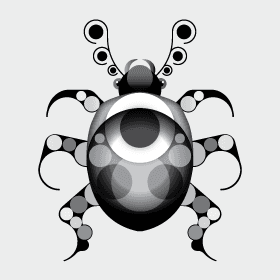bug
 Winner of the 2017 Best Combinatorial Game Award, Bug is a game where critters grow and eat each other in a competition for space. It can be played quickly on small boards or deeply on large boards.
Winner of the 2017 Best Combinatorial Game Award, Bug is a game where critters grow and eat each other in a competition for space. It can be played quickly on small boards or deeply on large boards.
Колькасць гульцоў: 2
Працягласць гульні: 4 mn
Складанасць: 3 / 5
Згуляйце ў bug і 1194 іншых гульняў онлайн.
Без запампоўкі, проста з вашага браўзэра.
З вашымі сябрамі і тысячамі гульцоў з усяго свету.
Гуляйце бясплатна.

Згуляйце ў bug і 1194 іншых гульняў онлайн.
Без запампоўкі, проста з вашага браўзэра.
З вашымі сябрамі і тысячамі гульцоў з усяго свету.
Гуляйце бясплатна.

Кароткія правілы
Gameplay
On your turn, you:
- Grow: Place a stone on any empty hex, to start a new bug or expand an existing one. However: You cannot use this action to merge two bugs, nor expand a bug to be larger than all other bugs on the board.
- Eat: All of your bugs which are adjacent to identically shaped opponent bugs "eat" those bugs, removing them from the board. You don't eat if you can't grow in that position.
- Bonus grow: If any of your bugs ate, you may grow them by 1 hex (so long as doing so does not merge any bugs).
First player who cannot place a stone on their turn wins. (You have "filled the ecosystem with your bugs so much you can no longer expand".)
Tips
- Don’t eat opponent critters when unnecessary. It’s almost always better to delay eating to the last moment. When you eat your opponent’s critter, you also give your opponent more flexibility.
- While it can be fun to capture multiple opponent bugs at once, it’s dangerous, because it gives your opponent a lot of flexibility to counterattack.
- Try to minimize the number of moves you have left to play and maximize your opponent’s. In the late stage if there is no tactical advantage to be gained, fill the cells that only you can fill before the ones that both you and your opponent can fill.
- Ultimately, you want to make captures that don’t lead to opponent counter-captures. At first this is impossible. So early, you need to build your position, so when it becomes possible to prevent counter-captures, you can do so better than your opponent. It’s all positioning, and it takes a while to learn this skill.
- The difficulty of building shapes, and therefore the difficulty of defending and attacking shapes, is governed by a hierarchy. Over time and experience, it's possible to understand this hierarchy. Doing so will better help you decide which shapes to build, and which shapes to keep your opponent from building.
- On smaller boards, controlling a large amount of the second-most outer ring may be key to victory - it ensures you won't have to fill the outer ring, while your opponent will.
